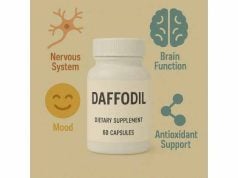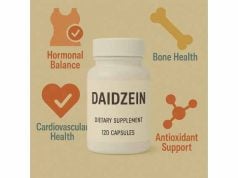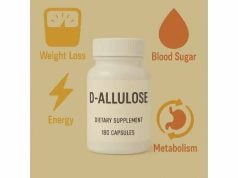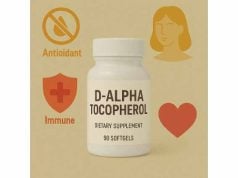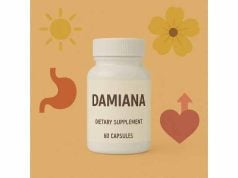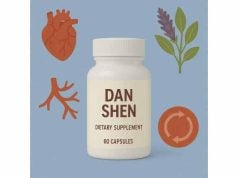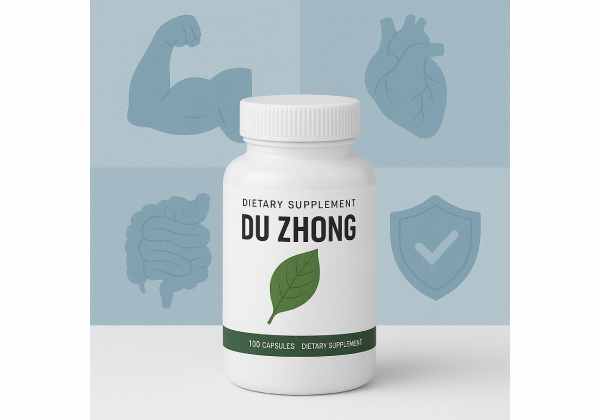
Du Zhong (Eucommia ulmoides), a cornerstone herb in East Asian medicine, is most often used for healthy blood pressure, resilient joints, and strong bones. Modern extracts concentrate its lignans, iridoids, and chlorogenic acids—the compounds studied for vascular relaxation, antioxidant support, and cartilage protection. Small clinical trials suggest Du Zhong can modestly lower blood pressure in mild hypertension, while animal and in-vitro data point to complementary benefits for bone metabolism and connective tissues. In everyday practice, people take Du Zhong as capsules, powders, or traditional teas; standardized extracts can help with consistency. This guide explains what Du Zhong is, how it works, realistic benefits and limits, practical ways to use it, evidence-based dosage ranges, and safety considerations—including who should avoid it and how to combine it sensibly with lifestyle and prescriptions.
Essential Insights for Du Zhong Users
- Supports healthy blood pressure; modest average reductions of ~5–8 mmHg seen in small trials.
- May aid joint comfort and bone metabolism through antioxidant and collagen-supporting compounds.
- Typical studied range: 1,500–3,000 mg/day of standardized bark extract; some products provide 0.48 g capsules equivalent to 2.5 g crude herb.
- May enhance effects of blood pressure medicines; monitor if you use antihypertensives or diuretics.
- Avoid if pregnant or trying to conceive, and in uncontrolled low blood pressure.
Table of Contents
- What is Du Zhong and how does it work?
- Evidence-backed benefits for blood pressure, bones, and metabolism
- How to choose and use Du Zhong extracts
- How much Du Zhong per day? Dosage guide
- Side effects, drug interactions, and who should avoid
- What the research says: quality, limits, and open questions
What is Du Zhong and how does it work?
Du Zhong is the Chinese name for Eucommia ulmoides, a hardy rubber tree whose bark (Eucommiae cortex) and leaves (Eucommiae folium) have been used for more than 2,000 years. In traditional practice, Du Zhong “tonifies liver and kidney,” language that—translated into modern physiology—roughly aligns with support for musculoskeletal strength, joint comfort, and cardiovascular steadiness. Today, supplements usually contain a bark extract standardized to one or more marker compounds so each dose is consistent.
What is in Du Zhong?
Key bioactive families include:
- Lignans such as pinoresinol diglucoside (PG), often used as a standardization marker (e.g., 8% PG in some clinical products). Lignans are associated with vasorelaxation and antioxidant actions.
- Iridoids (e.g., geniposidic acid, aucubin) thought to modulate inflammation and protect cartilage.
- Phenylpropanoids and chlorogenic acids, which can influence endothelial function and oxidative stress.
- Polysaccharides, large molecules with immunomodulating and antioxidant effects and emerging roles in metabolism and gut-microbiome interactions.
How might Du Zhong influence blood pressure?
Several mechanisms are proposed:
- Endothelial support and nitric oxide signaling. Components can relax vascular smooth muscle, improving arterial compliance.
- Beta-adrenergic modulation. One standardized extract showed mild beta-blocking activity in vitro, consistent with reduced sympathetic tone.
- Gut microbiome pathways. In animal models, bark extract shifted gut flora (e.g., enriching Parabacteroides) and dampened inflammatory signaling associated with salt-sensitive hypertension.
- Antioxidant and anti-inflammatory effects. By reducing oxidative stress, the vascular endothelium functions more efficiently.
Why do some products specify “bark” versus “leaf”?
Traditional formulas favor bark, but modern research also uses leaf preparations. Bark extracts tend to carry higher lignan and iridoid concentrations used in blood-pressure studies; leaf products are sometimes positioned for gentler, tonic use or as functional teas. Polysaccharide-rich fractions—present in both bark and leaf—are under active study for immune and metabolic effects.
Bottom line: Du Zhong is not a magic bullet, but as a standardized extract it can contribute to a comprehensive blood-pressure plan and may support joint and bone health. Effects are subtle and build over weeks; benefits depend on product quality, dose, and your baseline health.
Evidence-backed benefits for blood pressure, bones, and metabolism
Blood pressure (primary evidence).
Two human trials provide the most direct insights. A small randomized, controlled study tested an aqueous bark extract standardized to 8% pinoresinol diglucoside. At 1,000 mg three times daily for two weeks, participants reduced average 24-hour blood pressure by about 7.5/3.9 mmHg compared with baseline; a lower dose (500 mg three times daily for eight weeks) did not separate from control on 24-hour monitoring but was well tolerated. A more recent multicenter, randomized, double-blind, placebo-controlled study of commercial Quanduzhong capsules (a Eucommia bark extract medicine used in China) in grade-1 hypertension found office systolic and diastolic blood pressure fell by roughly 8/5 mmHg over four weeks versus placebo, with mild adverse events and no significant lab abnormalities. Together, these trials suggest Du Zhong can produce modest reductions in clinic blood pressure and may smooth day-night variability—most useful for people at the mild end of the spectrum or as an adjunct to lifestyle measures.
Joint comfort and bone health (emerging clinical relevance).
Preclinical models indicate iridoids such as geniposidic acid may protect cartilage, reduce inflammatory mediators, and help maintain matrix integrity—mechanisms consistent with traditional use for low back and knee discomfort. Reviews focused on Eucommia’s bioactive compounds in bone describe actions that encourage osteoblast activity, suppress osteoclast differentiation, and improve mineralization—mechanistic support for bone maintenance across the lifespan. While human trials for osteoarthritis or osteoporosis are limited, these pathways justify cautious, adjunctive use alongside exercise, adequate protein, calcium, and vitamin D.
Metabolic health and vascular biology (supportive data).
Animal and cell studies show Du Zhong may improve endothelial function, inhibit vascular smooth muscle proliferation, and modulate glucose and lipid handling. In mouse hypertension models, bark extract rebalanced gut microbes and reduced inflammatory signaling, aligning with human observations of improved blood-pressure variability. Polysaccharide-rich fractions demonstrate antioxidant and immunomodulatory activity that could indirectly benefit cardiometabolic health, though clinical endpoints remain to be proven.
What these benefits mean for you.
- Expect incremental improvements—think of Du Zhong as a supportive nudge, not a replacement for proven therapies.
- Effects often appear by 2–8 weeks on a consistent regimen.
- Benefits are strongest when paired with diet, sleep, physical activity, and stress management; Du Zhong may amplify those gains.
- If you take antihypertensives, monitor blood pressure regularly when adding Du Zhong to avoid over-lowering.
Where evidence is weakest.
Claims for weight loss, dramatic athletic gains, or rapid pain relief are not supported by strong human data. Use skepticism when products promise fast, sweeping changes.
How to choose and use Du Zhong extracts
1) Pick the right form for your goal.
- Standardized bark extract capsules or tablets are best for blood-pressure support because clinical trials used this format. Look for identification of Eucommia ulmoides bark (Eucommiae cortex) and a standardization marker (e.g., % pinoresinol diglucoside or chlorogenic acids).
- Traditional teas and decoctions (bark or leaf) are gentler and part of culinary traditions. They deliver a broader profile of compounds but with variable potency.
- Powders and tinctures offer flexibility, though standardization is less common; confirm third-party testing.
2) Read the label like a pro.
- Species and plant part: “Eucommia ulmoides (bark)” or “Eucommiae cortex.”
- Extract ratio: e.g., 10:1. Higher ratios are not always more effective; consistency matters more.
- Standardization: e.g., “standardized to 8% pinoresinol diglucoside (PG).”
- Serving specifics: mg per capsule, capsules per day, and total daily mg.
- Quality markers: cGMP manufacturing, third-party testing (USP, NSF, or ISO-accredited labs), and absence of adulterants (heavy metals, pesticides).
3) Timing and combinations.
- With meals is typical to reduce stomach upset, unless your product directs otherwise.
- Combine Du Zhong with foundational habits—salt moderation, potassium-rich foods (unless restricted), fiber, and regular movement.
- Complementary botanicals sometimes paired with Du Zhong include hawthorn (vascular support), garlic (lipids and BP), and fish oil (triglycerides). Start one change at a time so you can track effects.
4) Manage expectations and track progress.
- Check your home blood pressure (validated cuff) at the same times of day; log averages over a week before and after starting.
- Give a trial of 4–8 weeks at a consistent dose before judging its value.
- If you notice dizziness, fatigue, or readings below your target, reduce or stop and consult your clinician.
5) Know your product’s equivalence.
Some regulated Quanduzhong capsules in clinical use provide 0.48 g per capsule equivalent to about 2.5 g of crude herb. Supplement-market products vary widely; equivalence depends on extraction ratio and marker content. Use equivalence as context, not a direct dosing rule, because preparations differ.
Practical example.
If your product provides 500 mg standardized bark extract per capsule, a common pattern is one capsule three times daily (total 1,500 mg/day), reassessed after 4–8 weeks. For stronger regimens, clinicians sometimes consider up to 1,000 mg three times daily in short trials—as used in research—if tolerated and medically appropriate.
How much Du Zhong per day? Dosage guide
There is no universal dose, but clinical and traditional usage provide practical guardrails. Standardized bark extracts have been studied at the following levels:
- 1,500 mg/day (500 mg three times daily) of an aqueous bark extract standardized to ~8% pinoresinol diglucoside for 8 weeks: well tolerated; 24-hour ambulatory blood pressure did not clearly separate from control in that arm.
- 3,000 mg/day (1,000 mg three times daily) of the same standardized extract for 2 weeks: average reduction of about 7.5/3.9 mmHg in ambulatory blood pressure compared to baseline, with good tolerability.
- Quanduzhong capsules in a 4-week randomized, double-blind trial produced ~8/5 mmHg mean office blood-pressure reductions versus placebo. Each regulated capsule in that program contained 0.48 g and was described as equivalent to ~2.5 g crude herb; dosing followed the product’s approved schedule.
Suggested approach for adults (with clinician guidance):
- Start low: 500 mg of standardized bark extract once daily for 3–4 days to assess tolerance.
- Titrate: Increase to 500 mg two to three times daily (total 1,000–1,500 mg/day).
- Reassess at 4–8 weeks: If targets are unmet and you tolerate it, a monitored increase toward 2,000–3,000 mg/day may be considered for short periods.
- Maintenance: Use the lowest effective dose alongside lifestyle measures and prescribed medications as indicated.
For teas and decoctions.
Potency varies markedly by plant material and brewing method; without standardization it is difficult to equate to capsule doses. If you prefer tea, treat it as adjunctive and continue objective monitoring.
Special situations:
- Older adults or those with multiple medications: Stay at the low end (e.g., 500–1,000 mg/day) unless supervised.
- Athletes and active individuals: Du Zhong will not replace training, sleep, or dietary protein, but may support joint comfort over time; routine doses as above are appropriate.
- When combining with antihypertensives: Start conservatively and monitor; Du Zhong may enhance blood-pressure-lowering effects.
What not to do: Do not exceed label directions; do not chase rapid drops in blood pressure; and do not use Du Zhong to self-treat moderate to severe hypertension in place of guideline-directed care.
Side effects, drug interactions, and who should avoid
Overall tolerability.
Across controlled studies, Du Zhong bark extract has been well tolerated. Reported side effects are typically mild and transient—headache, lightheadedness, digestive upset, or a “cold-like” feeling. In the 4-week randomized trial of Quanduzhong capsules, no significant abnormalities in liver or kidney labs were observed and adverse effects were mild.
Possible risks to watch for.
- Excessive blood-pressure lowering. If you already take antihypertensive medications or have naturally low blood pressure, Du Zhong may add to their effects, increasing the risk of dizziness or faintness—especially when standing quickly. Monitor at home and coordinate with your clinician.
- Additive effects with diuretics or vasodilators. Theoretical interactions exist where Du Zhong’s vasorelaxant activity could intensify these medicines.
- Surgery and anesthesia. Because it may influence hemodynamics, consider stopping Du Zhong 1–2 weeks before elective procedures unless your surgical team advises otherwise.
- Allergy or intolerance. Rare, but discontinue if you develop rash, swelling, or breathing difficulty.
Pregnancy, fertility, and lactation.
Traditional texts sometimes describe Du Zhong as “calming the fetus,” yet modern safety data are insufficient. Out of caution, avoid Du Zhong if you are pregnant, trying to conceive, undergoing fertility treatment, or breastfeeding unless a qualified clinician recommends it and monitors you.
Medical conditions requiring caution.
- Uncontrolled hypotension or orthostatic intolerance
- Advanced kidney or liver disease (limited data; ensure medical supervision)
- Complex polypharmacy (many prescriptions) where blood-pressure variability is dangerous
Quality and contamination concerns.
As with all botanicals, choose reputable brands with third-party testing to avoid heavy metals, pesticide residues, or adulteration. If a product lists proprietary blends without marker compounds or mg amounts, consider alternatives with clearer labeling.
When to stop and seek care.
Stop using Du Zhong and contact your clinician if blood pressure drops below the plan you set together; if you experience severe dizziness, chest pain, shortness of breath, palpitations, fainting, or unusual swelling; or if lab tests become abnormal.
What the research says: quality, limits, and open questions
What is relatively strong:
- Human blood-pressure data exist, including a multicenter randomized, double-blind, placebo-controlled trial of a regulated Eucommia capsule and an earlier randomized extract study. Both found modest reductions in office or 24-hour blood pressure over 2–4 weeks, with good tolerability.
- Mechanistic plausibility is robust. Lignans and iridoids support vasorelaxation and antioxidant pathways, while gut-microbiome shifts correlated with lower blood pressure and inflammatory tone in animal models.
- Bone and joint mechanisms are increasingly mapped: stimulation of osteoblasts, inhibition of osteoclasts, and cartilage-protective effects. Reviews from the last few years synthesize these findings and highlight leads for future clinical trials.
What is weaker or missing:
- Sample sizes are small and durations short (weeks, not months or years). We lack large, long-term trials with hard outcomes (e.g., cardiovascular events).
- Product heterogeneity makes cross-study comparisons difficult. Extract ratios, marker compounds, and standardizations differ across brands and countries.
- Clinical endpoints beyond blood pressure (e.g., osteoarthritis pain scores, bone mineral density) have limited or predominantly preclinical evidence.
How to interpret the blood-pressure effect size.
A reduction on the order of 5–8 mmHg systolic may sound modest, yet it is clinically meaningful when combined with lifestyle changes—especially for people with high-normal or grade-1 hypertension. Importantly, variability control (e.g., smoother day-night shifts) can be beneficial even when average values change only slightly.
Standardization and reproducibility.
Seek products that state species, plant part, extract ratio, and a marker (commonly pinoresinol diglucoside or chlorogenic acids). In clinical contexts, some 0.48 g regulated capsules specify herb equivalence (≈2.5 g crude herb per capsule), an approach that improves traceability. Over time, greater harmonization of markers and extract profiles across studies will make dosage guidance clearer.
Open questions worth watching:
- Do specific lignan-rich or iridoid-rich profiles outperform generic extracts for blood-pressure variability?
- Can polysaccharide fractions meaningfully affect metabolic markers or immune tone in humans?
- What is the sustained effect and safety profile over 6–12 months of continuous use?
- How do microbiome changes mediate benefits, and can diet composition (e.g., salt intake, fiber) enhance Du Zhong’s impact?
Bottom line: The research trajectory is promising but incomplete. For motivated adults with mild hypertension already working on lifestyle, Du Zhong can be a measured, evidence-aware addition—ideally supervised, monitored, and paired with quality sourcing.
References
- A clinical trial testing the safety and efficacy of a standardized Eucommia ulmoides Oliver bark extract to treat hypertension 2011 (RCT)
- Quanduzhong capsules for the treatment of grade 1 hypertension patients with low-to-moderate risk: A multicenter, randomized, double-blind, placebo-controlled clinical trial 2023 (RCT)
- Eucommia ulmoides bark extract reduces blood pressure and inflammation by regulating the gut microbiota and enriching the Parabacteroides strain in high-salt diet and N(omega)-nitro-L-arginine methyl ester induced mice 2022 (Mechanistic, Animal)
- Advances in Eucommia ulmoides polysaccharides: extraction, purification, structure, bioactivities and applications 2024 (Systematic Review)
- Eucommia ulmoides Oliv. and its bioactive compounds: therapeutic potential in bone diseases 2025 (Review)
Disclaimer
This information is for educational purposes and is not a substitute for personalized medical advice, diagnosis, or treatment. Du Zhong can influence blood pressure and may interact with medications. Always consult a qualified healthcare professional before starting, stopping, or combining supplements—especially if you have cardiovascular disease, kidney or liver disease, are pregnant, planning pregnancy, or breastfeeding.
If you found this guide helpful, consider sharing it with a friend or on Facebook, X (formerly Twitter), or your favorite platform, and follow us for future updates. Your support helps us continue creating careful, evidence-based resources.

